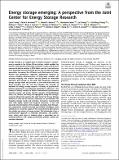Energy storage emerging: A perspective from the Joint Center for Energy Storage Research
Author(s)
Brushett, Fikile R; Chiang, Yet-Ming
DownloadPublished version (1.233Mb)
Publisher Policy
Publisher Policy
Article is made available in accordance with the publisher's policy and may be subject to US copyright law. Please refer to the publisher's site for terms of use.
Terms of use
Metadata
Show full item recordAbstract
Energy storage is an integral part of modern society. A contemporary example is the lithium (Li)-ion battery, which enabled the launch of the personal electronics revolution in 1991 and the first commercial electric vehicles in 2010. Most recently, Li-ion batteries have expanded into the electricity grid to firm variable renewable generation, increasing the efficiency and effectiveness of transmission and distribution. Important applications continue to emerge including decarbonization of heavy-duty vehicles, rail, maritime shipping, and aviation and the growth of renewable electricity and storage on the grid. This perspective compares energy storage needs and priorities in 2010 with those now and those emerging over the next few decades. The diversity of demands for energy storage requires a diversity of purpose-built batteries designed to meet disparate applications. Advances in the frontier of battery research to achieve transformative performance spanning energy and power density, capacity, charge/discharge times, cost, lifetime, and safety are highlighted, along with strategic research refinements made by the Joint Center for Energy Storage Research (JCESR) and the broader community to accommodate the changing storage needs and priorities. Innovative experimental tools with higher spatial and temporal resolution, in situ and operando characterization, first-principles simulation, high throughput computation, machine learning, and artificial intelligence work collectively to reveal the origins of the electrochemical phenomena that enable new means of energy storage. This knowledge allows a constructionist approach to materials, chemistries, and architectures, where each atom or molecule plays a prescribed role in realizing batteries with unique performance profiles suitable for emergent demands.
Date issued
2020-06Department
Massachusetts Institute of Technology. Department of Chemical Engineering; Massachusetts Institute of Technology. Department of Materials Science and EngineeringJournal
Proceedings of the National Academy of Sciences of the United States of America
Publisher
Proceedings of the National Academy of Sciences
Citation
Trahey, Lynn et al. “Energy storage emerging: A perspective from the Joint Center for Energy Storage Research.” Proceedings of the National Academy of Sciences of the United States of America, 117, 23 (June 2020): 12550–12557 © 2020 The Author(s)
Version: Final published version
ISSN
0027-8424